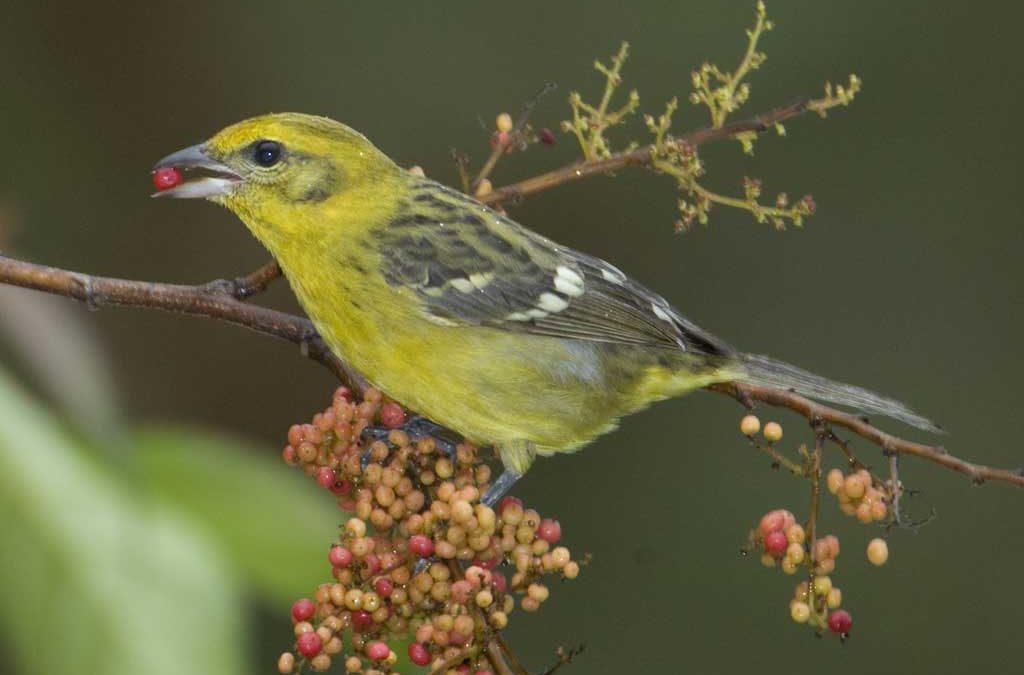Plans for a four-day birding adventure to Southeast Arizona (May 17-20) were worked out in advance of the pair of Flame-colored Tanagers arriving in Ramsey Canyon on or around May 9th. When I heard reports of these rare visitors from Mexico gathering nesting material in the canyon, I relaxed and hoped they would hang around so I could get to see them.
Kay Hawklee, a birder I met on Melody Kehl’s Big Bend birding trip, was interested in my proposed plan during which I would be focusing on seeing birds that I haven’t yet seen this year in Arizona. Kay, having been birding now for all of four months assumed, rightly, that if I was searching for birds, she was bound to gather some good ones for herself and she jumped on board.
Day # 1: Sunday, May 17th.
Kay drove as we headed south to where we began birding at Las Cienegas National Conservation Area via its western entrance at 8:45 a.m. At the first pull-off, we immediately heard birds singing. I discerned them to be Botteri’s but took photos to confirm (or not) its identification since they were perched quite a distance from us.
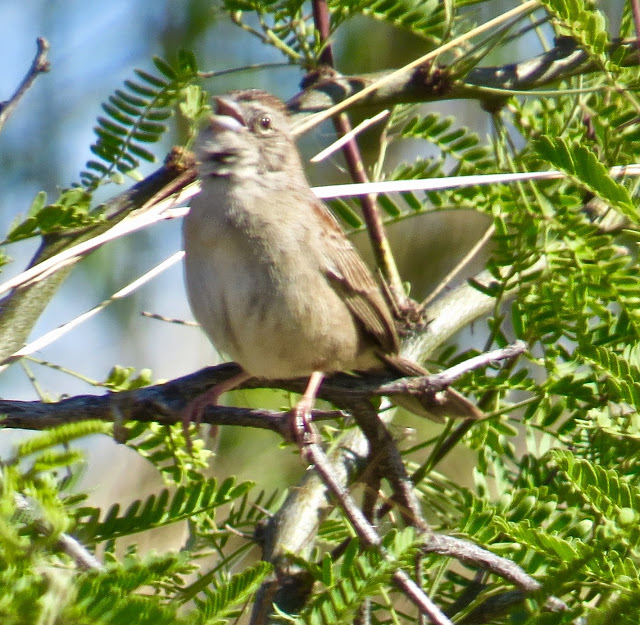
Botteri’s Sparrow
At the tank and corral area, we had more sparrows singing and popping up and down on the grasses and within the mesquite trees: Cassin’s, Lark and Grasshopper were our best finds.
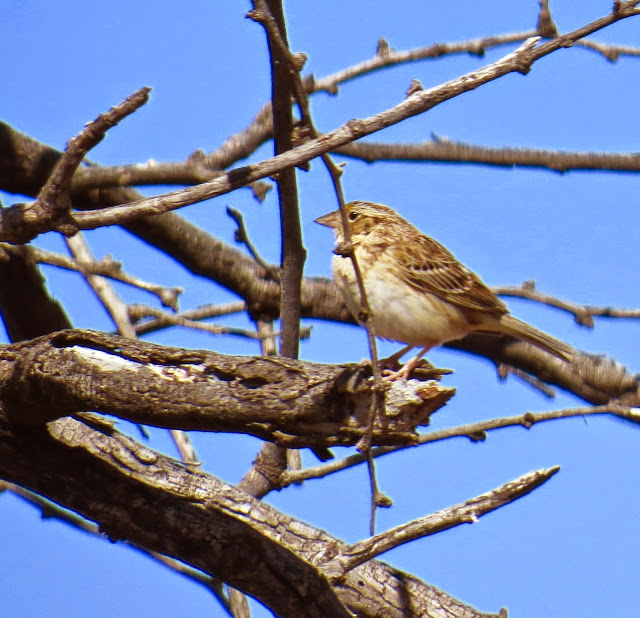
Grasshopper Sparrow
In a dry patch of brown earth, Kay spotted a Horned Lark walking around by itself. Usually I see them in flocks, but this one was out on its own today.
Within the same conservation area, we drove over to Empire Gulch, parking at the cottonwood lot. Larry Morgan (caretaker at Tucson Audubon’s Paton House), was just leaving, having shown some of his Mississippi family this cool birding spot.
A previously reported Northern Waterthrush at this marsh area would be a Lifer for me if I could find it!
The trail leads to soggy ground and marshy areas. We met Betsy Checchia, whose name I recognized from the ListServ. Some of our best sightings included a Gray Hawk, Greater Roadrunner, Western and Summer Tanagers, Black-headed and Blue Grosbeaks and one Bullock’s Oriole. Kay found an Empidomax that only she saw. It’s tough enough to ID them when I actually see them, let alone by verbal description, so she’ll figure it out.
Yet again, I dipped on finding the Northern Waterthrush.
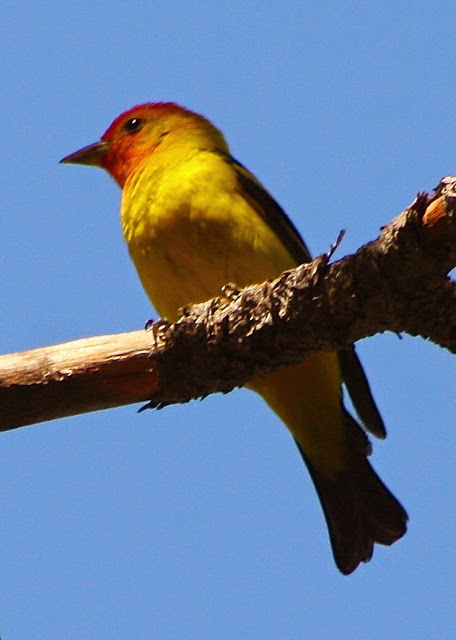
Western Tanager
From Las Cienegas, we headed to Madera Canyon. When Kay saw the sign to Madera Canyon (Greaterville Road), she quickly swung left and followed that dirt road rather than sticking to the longer highway route. At the dirt-road junction for Greaterville, we stayed right on FR 62 (South Forest Road, Sahuarita, AZ) all the way to where we both guessed it would end: Florida Canyon/Madera Road corner. It was a gorgeous drive through more grasslands and mesquite trees. The 28-mile trip took 1.5 hours through quiet wilderness…we loved it.
In Madera Canyon, we went first to Kubo B&B mainly because no parking spots were open at Santa Rita Lodge. It’s hosting a rare hummingbird: the Plain-capped Starthroat. In the 15 minutes we spent at the Kubo bird sanctuary, we managed to see, among many other birds, one Magnificent Hummingbird and heard an Elegant Trogon barking – a new experience for Kay.
At Santa Rita Lodge, we found a parking spot and had been there only about 20 minutes when I saw a large hummingbird land on the back of a feeder. I asked Cindy Marple, standing next to me, “What just landed on Feeder 11?”
Thus, we got to see the rare Mexican hummingbird that is among the largest of hummingbirds. It’s rather drab but very startling to see at a feeder with normal-sized hummingbirds like Broad-billed or Black-chinned.
Since I wanted to do some Owling in the evening and we had left the Phoenix Valley quite early, we left Madera Canyon around 3:30 to check into our motel. After resting for an hour or so, we ate a light dinner before heading off to Madera Canyon again. Several birders arrived as we did around 7 p.m.at Santa Rita Lodge to watch for the Elf Owl. The Elf Owl lives in a pole full of woodpecker holes. Someone pointed out the precise hole to watch and at 7:30, the Elf Owl came to the front of its hole. We got good views of it for 5 or 10 minutes before darkness began to hide it and it flew off.
Bird guide, Richard Frey was there and suggested we drop down one parking area to listen for the Whiskered Screech Owl but the most frequent call there was the Lesser Nighthawk. Before we left, I heard the Northern Pygmy Owl, not the Western Screech I was hoping for. So, we drove up toward the top of the paved road. Both Kay and I heard the Mexican Whip-poor-will calling from very close by so she just stopped in the middle of the dark empty road while we listened to it. As it continued, she pulled out her iPhone and recorded its voice! Very cool. (She later texted it to me, but I don’t know if I can attach it here.) At the top, we parked and began walking the Carrie Nation Trail using our phone flashlights. Western Screech Owl and Common Poorwill were vocal before we returned to the car and headed for Proctor Road which gave us nothing! What a long and rewarding birding day it had turned out to be!
Day #2: Monday, May 18th:
Dreams of the Flame-colored Tanager changed my plan. Some years ago, this Mexican visitor nested in Ramsey Canyon regularly, but hadn’t been seen there in five years.
So, instead of spending a precious day in Patagonia, we stopped only at the Roadside Rest Hot Spot where we immediately heard the Thick-billed Kingbird. Walking across Highway 82 gave us a great look at the bird perched on a high snag. Since it was into the sun, I took no photos since I had done that successfully two weeks ago. It was a nice stop to stretch our legs and do some extra birding for about 15 minutes.
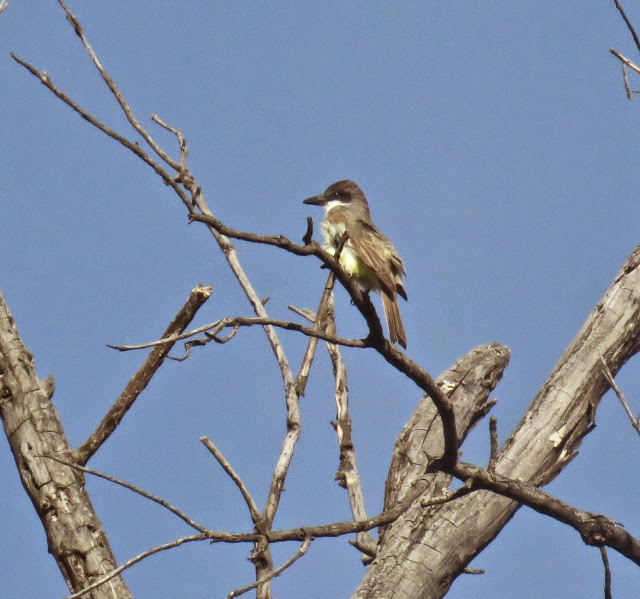
Then, our straight-forward drive to Sierra Vista brought us to Ramsey Canyon Preserve at 9:15 a.m. on Monday morning with no parking spots available. Kay, being a “newbie” shushed me out of the car and up the trail while she waited for a spot to open up for her car. This bird was not on her horizon. When I saw birders already coming down, I knew Kay would soon be joining me. The birders had seen both the male and female Flame-colored Tanagers. (Its name comes from the male’s coloring.) My excitement rose with each step up the trail.
I counted eighteen (18) birders gathered along a portion of upper the trail when I approached.
Melody Kehl was standing back, so I stopped briefly for a few words with her before walking forward into the gathered birders. Before sitting on the bench, I looked up in the trees behind us where I had just heard a “”pr-reck” call I didn’t know. It was the female Flame-colored Tanager. As usual, I spoke out: “Here it is!” Immediately, I got, “Did it have a dark bill?” Hmmm. I didn’t answer, but the gentleman soon got his answer at it flew over our path to an open branch where everyone saw the yellow running from its throat to its vent that I had seen. Also visible was its thick dark bill and dark auricular outline. Its wings, not obvious as she faced us, did carry two light wing bars and spots. (Western Tanager’s belly includes much more olive in the yellow.) After moving around briefly, the female settled into a nest well-hidden behind tangles. A very loud family was bothering the heck out of me and I didn’t follow them around the trail to look up into the nest but when they started taking photos, I wandered over there. I had decided to enjoy the birds instead of taking photos, but with the female settled, I wanted to see what I might get. Tangles were thick and no matter how many times I was told the location of the nest, I didn’t really find it. I returned to the other side of the loop. Kay had arrived and would see both the male and female as they came in later.
With the colors of those tropical birds imprinted on my brain, I was in awe of their beauty and appreciative of their crossing the border this year for its nesting location.

Online photo of female Flame-colored Tanager.
I had been surprised to find an active nesting area of rare birds open to us for viewing. There was discussion among birders and Ramsey Canyon volunteers about closing this section of Bledsoe Loop but the consensus seemed to be to allow access for the birders. Hopefully, the attention of so many viewers and photographers will not drive the birds away.
As we reached the parking lot, we came upon Jim Ripley and Pam, just arriving for the Flame-colored Tanagers. If you follow on Facebook, “Birding Arizona and the Southwest,” you will see that he was quite successful in his quest for a “decent” photo!!
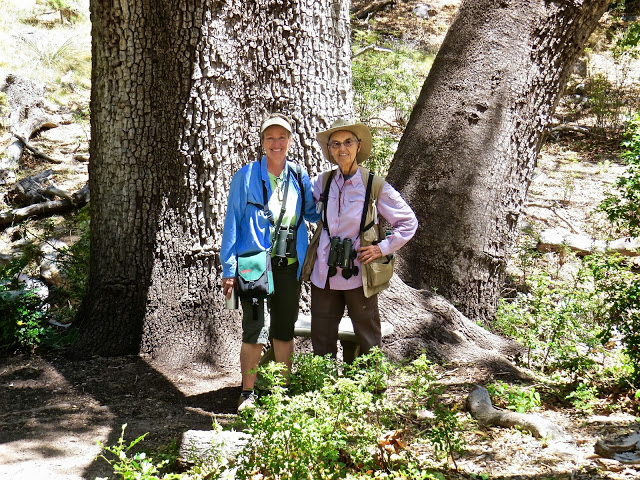
Kay and Babs, Ramsey Canyon
At that point, we took a break before venturing up Carr Canyon later in the afternoon. While my goal had been to see if any Red Crossbills or Buff-breasted Flycatchers remained at Reef Campsite, I really didn’t know the distance and it turned out to be rather significant. (7 miles over rough dirt road) We didn’t start up the canyon until after 6 p.m., and, after a while, it seemed that each time we rounded a hairpin turn, I expected to recognize the flat area of the campsite. With dusk approaching, we were chagrined to see a sign saying 4 miles to Reef Campsite. We pulled over after another mile or so at a somewhat wide curve. Enough!. We had a gorgeous view of Sierra Vista from where we were.
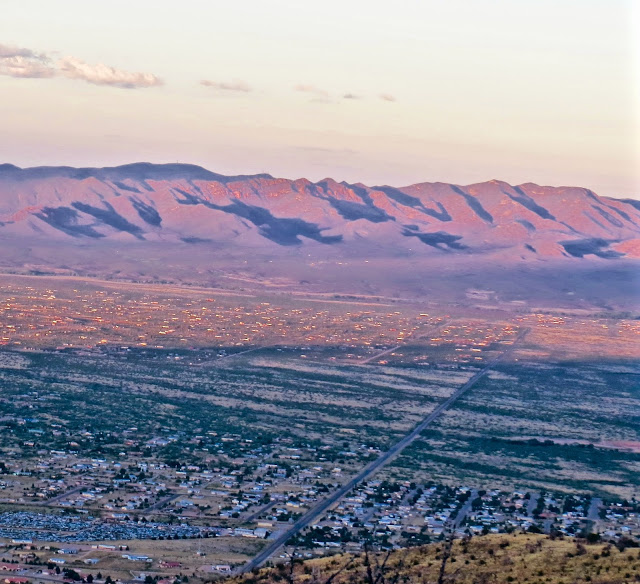
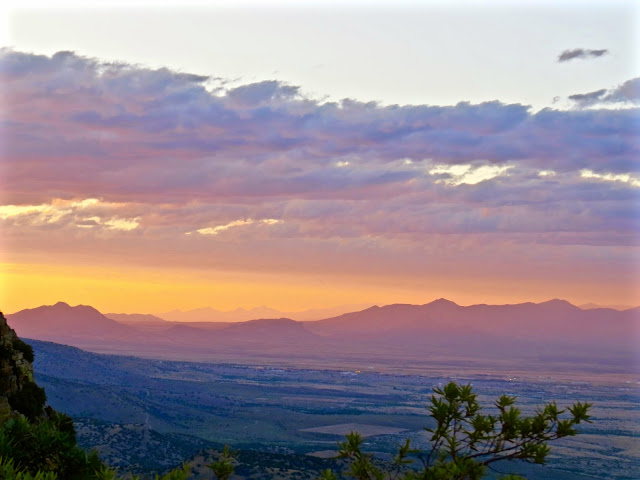
Day #3: Tuesday, May19th:
Today, our goal was to find an Elegant Trogon for Kay. Two weeks ago, I had been successful in locating them in Huachuca Canyon, but would they still be around? At the parking lot, we immediately heard two Elegant Trogons calling back and forth across the road leading from the parking area. Neither were visible, so I continued walking up canyon to see what other birds might be present. Kay caught up with me later and we birded until it seemed less “birdy” than around the parking area. A man, “Bill”, was coming down from above; he had gone up past the dam and found Grace’s Warblers but no Red-faced Warblers.
While I only got a glimpse of an Elegant Trogon, Kay watched persistently and was rewarded with a great look at a male ELTR, enough so that she got a very decent identification photo. Among the many birds in the canyon, the Sulphur-bellied Flycatcher was my favorite today.
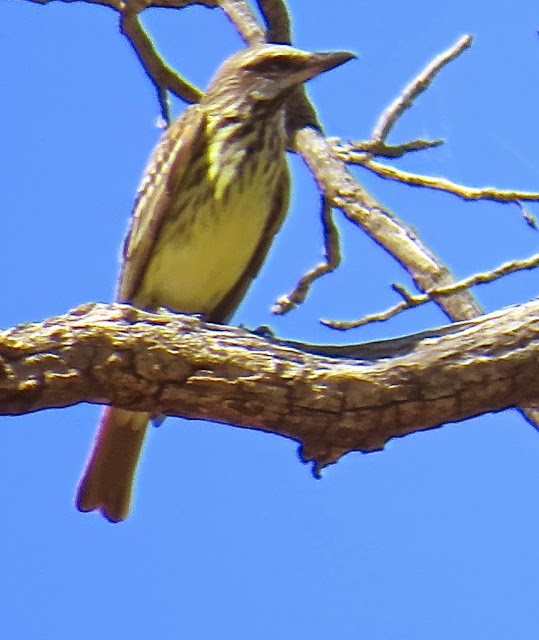
Back at the parking lot, we came upon Jim Ripley and Pam, again. He showed us his photo of the Flame-colored Tanager which was absolutely awesome. On Facebook, check out “Birding Arizona and the Southwest” to see his excellent photo of the male carrying food to the female.
Tony Battiste was also there with guests. He invited us over to his place for the evening to watch for the Montezuma Quail. Sounded good to us.
But first, we had other places to visit. The San Pedro House and trail were up to their usual good stuff when we arrived there next. We walked the loop out to and around Green Kingfisher Pond were I saw a Virginia Rail.
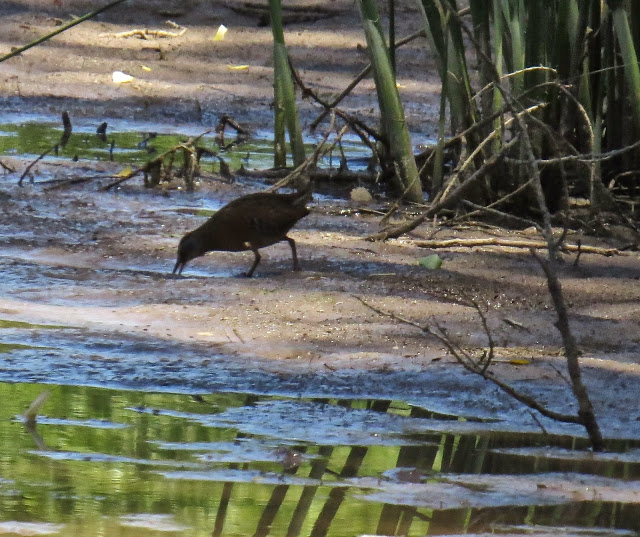
Kay seemed to have an affinity for the Common Yellowthroats, finding most all of them, including the female. Summer and Western Tanagers were present and Yellow Warblers were probably more present than the three I entered into e-bird. I never know how much they fly around but I could easily double that number and still not have counted all we heard.
Back at the San Pedro House, we got good looks at the Common Ground Dove, and Blue Grosbeak.
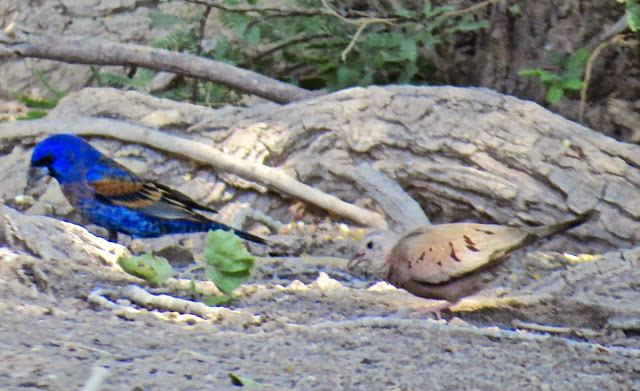
As we pulled out from the San Pedro Riparian National Conservation Area, a Chihuahuan Raven flew overhead.
A visit to Ash Canyon B&B resulted in our getting acquainted with a few other birders there; Mary Jo was inside and many of the feeders were empty. She departed for a bird-food shopping spree in town before we left.
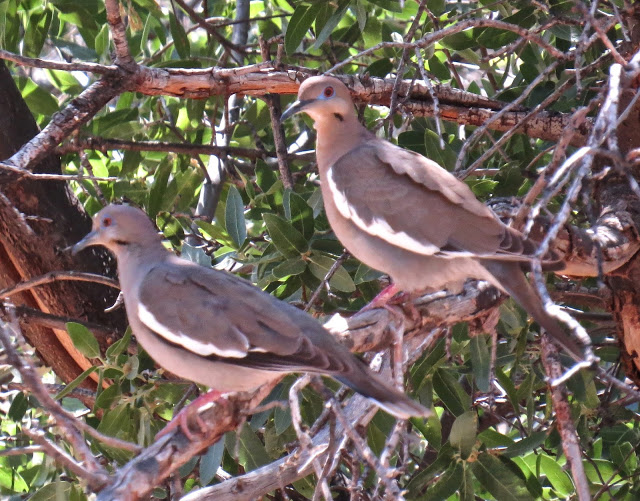
White-winged Doves
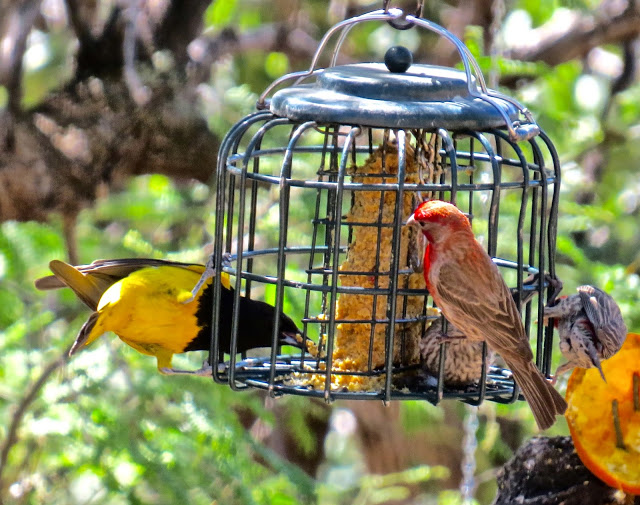
Scott’s Oriole on left; House Finches on right
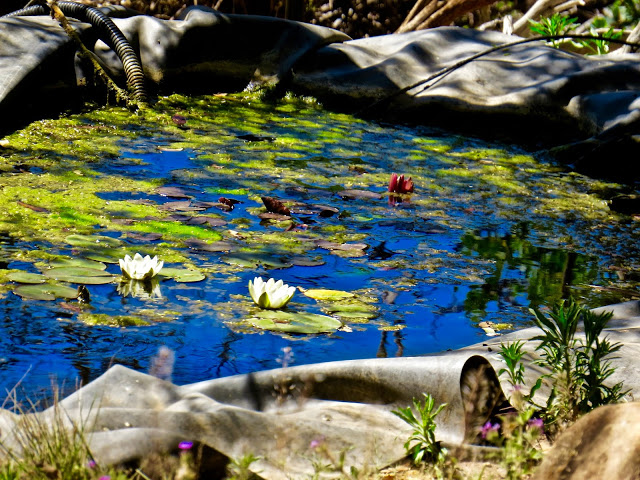
First waterlilies of the year on her pond
We still had time to visit Beatty’s Conservation Area to see if the male White-eared Hummingbird would show up. It surely did! The male is much more distinctive than the female as its broad white eyebrows contrast with its dark cheeks. I caught sight of it within the oak tree beside the feeders but when it came out to feed, its back was totally toward me, not showing its white stripes.
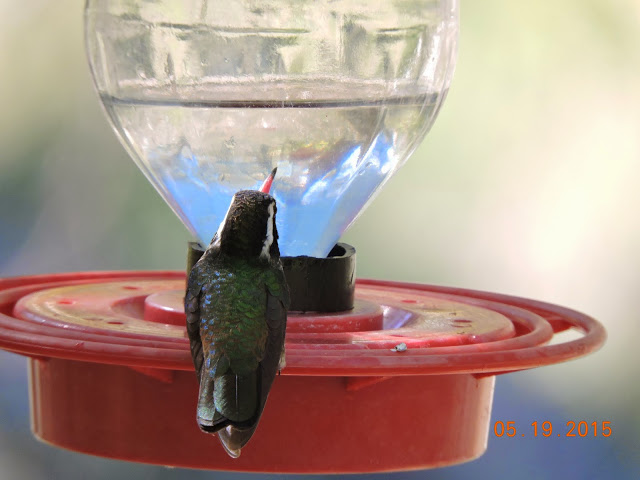
Kay’s photo of the male White-eared Hummingbird
Just before we left the hummingbird area, the folks we met at Mary Jo’s arrived since they hadn’t known the White-eared Hummingbird was present in Miller Canyon until we mentioned it upon leaving.
Also at the feeders, Magnificent Hummingbird gave better views of its size than its wonderful colors.
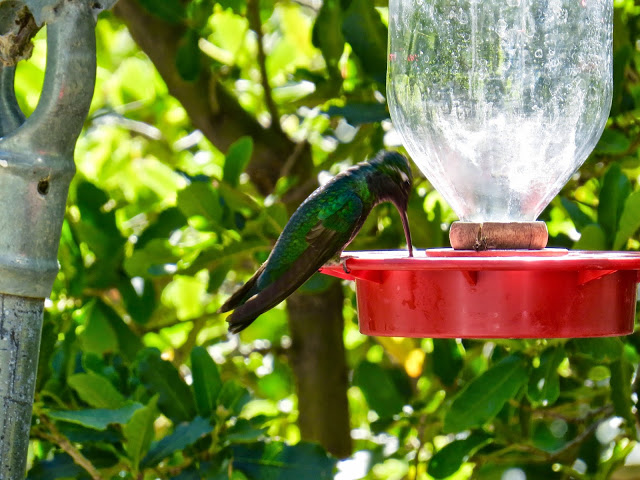
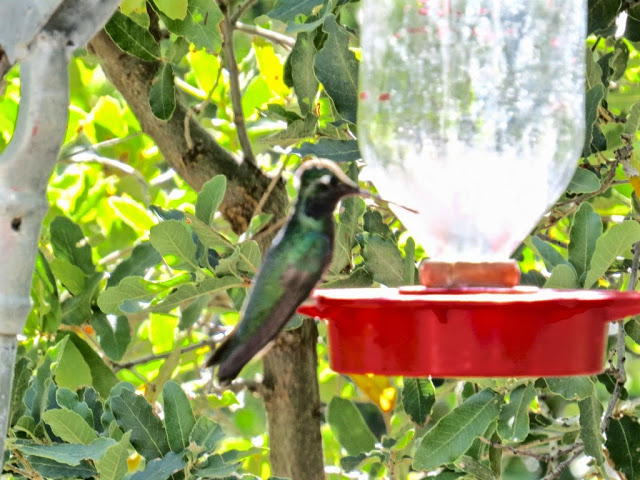
We definitely wanted to get over to Battiste Bed & Breakfast birding layout to see the Montezuma Quail that has been wandering into the Battiste yard every morning and evening for a couple weeks. Though it was after 5 p.m. when we arrived, Tony assured us the quail had not made its appearance. There were several birders already there, including Bill from Huachuca Canyon earlier in the morning. So, we sat. And, we sat. Julie came out to join us. Soon after, a small hummingbird – very colorful with a long decurved bill, flew in to sip from a magenta cholla cactus blossom. Tony was so surprised, he couldn’t get its name out. Finally, “LUCIFER”. Quite Rare, I knew. He told the two photographers to shoot. . .shoot….shoot…shoot. I think Tony’s excitement got them excited because none of their pictures turned out. And, when all was said and done, Tony’s camera stood on its tripod right in front of him and he never reached for it!! I didn’t bother with my camera. I’ve reached the point of wanting to see the bird before taking its photo. If it stays long enough, fine; if it doesn’t, at least I have seen something I’ve never seen before. Never had I observed a male Lucifer for that long in such a perfect setting: its magenta gorget matched that of the blossom — both lit up by sunlight. Gorgeous!

Online photo of male Lucifer Hummingbird
That male Lucifer Hummingbird made up for missing the Montezuma Quail.
Day #4: Wednesday, May 20th:
Time seemed to fly as we headed toward home. With a stop at Sweetwater to round out our list with the four possible kingbirds in Arizona with the Tropical – we were too late. We met the folks who had just seen them but we didn’t ferret them out from their location at or between the old Rogers Road Water Treatment Plant and Sweetwater. However, I got better photos of the Olive-sided Flycatcher than I had taken toward dusk when Lois and I stopped by there about a week ago.
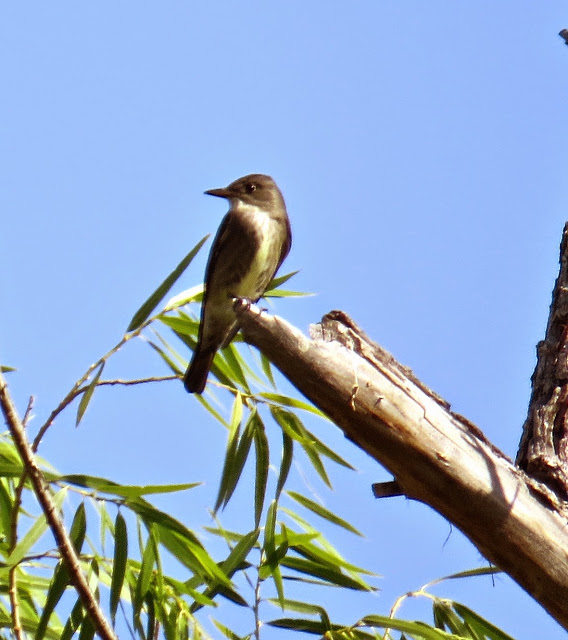
Kay dropped me at the house around noontime and headed home to Sedona, a long lot of driving for her. She was great company, a sharp spotter, and is being well-trained by Dena of Jay’s Bird Barn in Sedona. We’re likely going to be seeing more of her in the field.
Total species observed on the trip: 117

